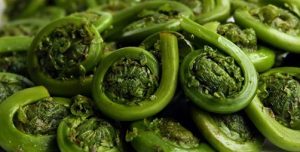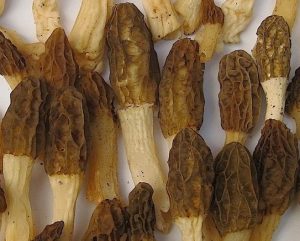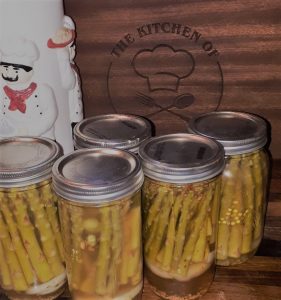
The rainy dreary daze that April sometimes leaves us with, is quickly overcome when we think that just a couple of weeks after the weather warms, we are feasting on springtime’s terrific three. Earths bountiful harvest begins in spring, with Fiddlehead’s, Asparagus and Morel mushrooms, bursting through the ground and ready for the picking.
Fiddlehead’s and Asparagus are actually part of the fern family of plants, they are the tender shoots (or the crown) of the plant before they burst open in full bloom. In the original Persian, asparag, meaning “shoots.” Asparagus were cultivated as far back as ancient Egypt, they have been renowned for centuries in medicine for their diuretic properties. While the Greeks and Romans enjoyed the plant they fell out of favor in the middle ages, yet King Louis XIV reintroduced them to the menu in the 17th century and they have remained a favorite ever since.
There are a couple of rarer types of asparagus, white and purple, white asparagus is picked (rather dug up) before the shoots burst through the ground. While purple gains its color from anthocyanin, a type of pigment, they also contain a slightly higher sugar content. While the colors differ greatly, flavors are just slightly different, while white is mild, purple sweeter and green more robust. For a great plate presentation use all three, green, white and purple.
Fiddleshead’s, are the “fond’s” the first shoots, of an edible fern, The Lady Fern or the Ostrich Fern depending on your locale. The fresh fronds of edible ferns are very high in antioxidant like vitamin-A, more than 120% of recommended the daily need they also contain and carotene, and are the great source of nutrients, minerals and electrolytes. Electrolytes like potassium, manganese, iron, and copper.
Give the plant a quick rub to remove the chaff, then wash a couple times in a a lightly salted water bath. This will remove and soil and any possible insects from the plant, after all you are searching the forest to harvest them.
Never ear raw Fiddlehead’s, they are bitter (slightly) in their raw state, which if consumed in any quantity may give a minor upset stomach. You’ll want to blanch them, this removes the bitterness and prepares them for your final stage of culinary delights. Trim the ends to remove any off color parts, then, cook for 1 – 2 minutes in a large pot of rapidly boiling, salted water. Drain the fiddleheads and quickly plunge into cold water to retain their crispness and to stop the cooking process, drain and reserve until you require them. At this stage you can allow them to air dry, then place on a parchment lined cookie sheet and freeze, once frozen you can place them into a freezer bag for restaurant quality IQF (individual quick frozen) veggies.
Finish them for service by quickly tossing in a sauté pan with a little butter along with a flavoring accompaniment, such as herbs, garlic, sun-dried tomato, or served with Hollandaise, Bearnaise, or Choron sauces.
Molly Moocher, Hickory Chicken, Miracle Dryland Fish all names of one of world’s tastiest mushrooms, the mighty Morel. Think of the story book pictures of your childhood, those conical mushrooms, could they really morel mushrooms.
Insert Smurfs mushroom here Buy this print here (not affiliate with Chef K) https://www.art.com/products/p39902568675-sa-i9945038/smurfs-mushroom-meadow-cottage.htm
Now is the hunting seasoning for Morels, know what you are seeking, while mushroom hunting is very rewarding, picking the wrong one could have terrible results, you must be very cautious. Try the following link to give you the heads up when the mushrooms pop their heads up. http://www.foragingguide.com/mushrooms/sp/morel
 In 2002 huge forest fires swept through the BC interior, divesting 1000’s of acres and burning more than five hundred homes. Yet the following year the Morel mushrooms were so abundant that mushroom pickers were selling the earth gems at the back door of our restaurant for as little as 2.50 lb. An amazing price, considering they can sell anywhere from 50-100 per pound. Pick your own and then dry them for later, just soak in warm water to rehydrate.
In 2002 huge forest fires swept through the BC interior, divesting 1000’s of acres and burning more than five hundred homes. Yet the following year the Morel mushrooms were so abundant that mushroom pickers were selling the earth gems at the back door of our restaurant for as little as 2.50 lb. An amazing price, considering they can sell anywhere from 50-100 per pound. Pick your own and then dry them for later, just soak in warm water to rehydrate.
Morel Mushroom and Asparagus Sauté
3 quarts water
12 ounces white asparagus, trimmed
12 ounces purple asparagus, trimmed
12 ounces green asparagus, trimmed
2 tablespoons butter
1 shallot, thinly sliced
4 cups fresh morel mushrooms, halved lengthwise (about 8 ounces)
1/2 teaspoon kosher salt, divided
2 tablespoons oil packed sun-dried tomatoes
1/4 teaspoon freshly ground black pepper
Directions
Bring 3 quarts water to a boil in a large saucepan. Peel bottom 2 inches asparagus. Cook asparagus in boiling water 5 minutes or until crisp-tender; remove with a slotted spoon to a colander. Rinse under cold water; drain well. Cut asparagus diagonally into 1 1/2-inch pieces.
Melt butter in a large nonstick skillet over medium-high heat; swirl to coat. Add shallot; sauté 1 minute, stirring constantly. Add morels and 1/4 teaspoon salt; sauté 5 minutes or until mushrooms are lightly browned. Add asparagus, remaining 1/4 teaspoon salt, sun-dried tomatoes, and pepper; toss gently to coat. Cook 2 minutes or until asparagus is thoroughly sauteéd.
CHEF K’S PICKLED ASPARAGUS

These sell for as much as $38.00 per jar, save a lot and make your own.
For each quart jar, you will need:
1 clove of garlic
1/4 teaspoon sea salt
1 teaspoon organic dill
1 teaspoon organic dried oregano
1 teaspoon pickling spice
1/4 teaspoon organic ghost pepper flakes
10-20 spears of fresh & local asparagus, depending on spear size
Pickling Brine
6 cups Pickling vinegar
6 cups water
4 tablespoons pickling salt
2 tablespoons sugar
DIRECTIONS:
- Wash and sterilize your mason jars. Line up on the counter like little ducks in a row.
- Into each jar, put the garlic, red pepper flakes, sea salt, dill seeds, dried oregano, mustard seeds, and black peppercorns.
- Wash the asparagus and cut the bottom of the stem off so that the asparagus fits into the quart jar. Gently stuff each quart jar with as many asparagus spears as it will hold.
- Heat up a vinegar brine to near boiling.
- Once the vinegar brine is heated up, gently pour it into each asparagus filled quart jar, leaving 1/4″ head space at the top. Secure a sterilized lid and band onto each quart jar.
- Process the asparagus for 15 minutes in a boiling water bath canner. Gently remove and set on the counter to seal.